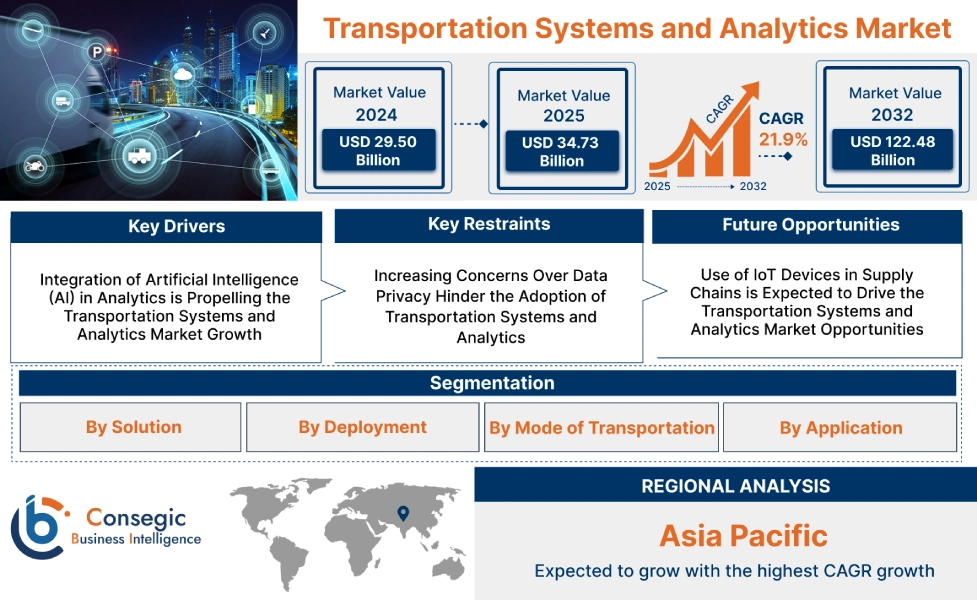Transportation Systems and Analytics Market Size:
Transportation Systems and Analytics Market size is estimated to reach over USD 122.48 Billion by 2032 from a value of USD 29.50 Billion in 2024 and is projected to grow by USD 34.73 Billion in 2025, growing at a CAGR of 21.9% from 2025 to 2032.
Transportation Systems and Analytics Market Scope & Overview:
Transportation systems and analytics refer to software or solutions that help companies or people manage their transportation needs, like the transportation of goods and fleet management. It encompasses a variety of software or solutions that help businesses streamline operations by lowering costs through improved logistics. Further, transportation systems have experienced growth due to the increasing need for governments to effectively manage traffic and improve road safety. Furthermore, the growing use of transportation systems and analytics for predictive analytics using advanced algorithms and IoT sensors has resulted in the development of the overall market.
How is AI Impacting the Transportation Systems and Analytics Market?
AI is reshaping the global transportation systems and analytics market by enabling smarter, safer, and more efficient mobility solutions. With advanced algorithms, AI enhances traffic management by analyzing real-time data to optimize signal timing, reduce congestion, and improve route planning. In public transit, AI supports predictive maintenance of vehicles and infrastructure, minimizing delays and operational costs. It also strengthens safety by detecting risks through video analytics and sensor data, helping prevent accidents. Additionally, AI-driven analytics provide valuable insights into passenger behavior and demand patterns, enabling better planning and resource allocation. As urbanization and smart city initiatives expand, AI is becoming central to building intelligent, data-driven transportation ecosystems worldwide.
Transportation Systems and Analytics Market Dynamics - (DRO) :
Key Drivers:
Integration of Artificial Intelligence (AI) in Analytics is Propelling the Transportation Systems and Analytics Market Growth
Artificial Intelligence algorithms have made it possible to make accurate predictions about daily transportation needs for businesses and end consumers. Many companies today offer predictive analytics using AI to streamline operations using both hardware and software. Hardware like IoT sensors allows businesses to effectively capture and then analyze the data using AI algorithms for better decision making.
- For instance, Intangles offers predictive analytics solutions using AI to offer vehicle health predictions by monitoring real-time data of the vehicles.
Hence, the increasing use of artificial intelligence for effective transportation system management and analytics is driving the market.
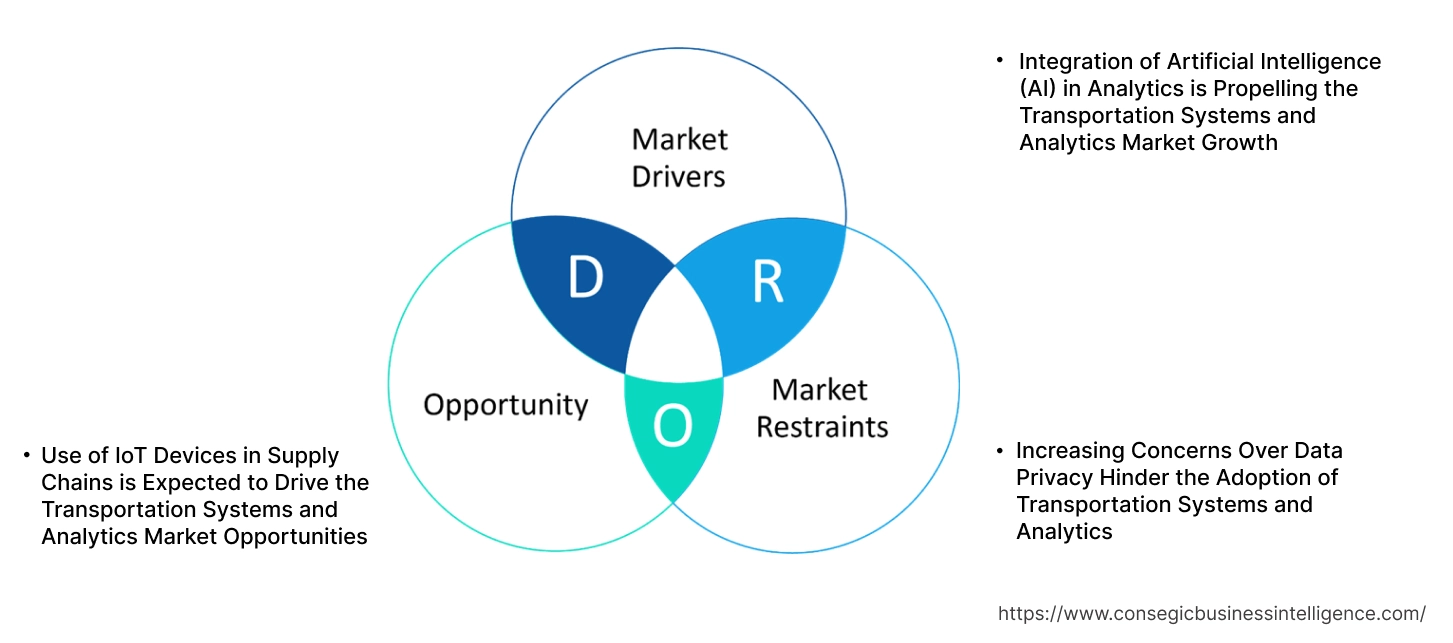
Key Restraints :
Increasing Concerns Over Data Privacy Hinder the Adoption of Transportation Systems and Analytics
Many companies collect transportation or vehicle-related data for effective transportation system management and analytics, resulting in data collection concerns among the users. The data that is collected can include location details and trip records of a specific user. Moreover, the transportation systems software handles sensitive information about different vehicles and their operations, so it becomes crucial to safeguard this data from cybersecurity threats. Thus, the rising data privacy concerns associated with the software for transportation management and analytics are restraining the market growth.
Future Opportunities :
Use of IoT Devices in Supply Chains is Expected to Drive the Transportation Systems and Analytics Market Opportunities
The supply chain process occurs in multiple stages, with last-mile delivery being a crucial and final stage. IoT sensors are being increasingly utilized for delivering real-time information, including the temperature of packages, which can be useful for the proper delivery of food and pharmaceutical packages. Many companies today have started offering IoT solutions to help businesses control costs and ensure timely delivery of goods to end consumers, which is driving the transportation systems and analytics market demand.
- For instance, TCSoffers IoT solutions like TCS DigiFleet to provide real-time data to allow companies to find the most efficient routes for timely delivery by providing expected time arrivals and live updates.
Thus, rising adoption of IoT solutions for use in supply chains is projected to drive the transportation systems and analytics market opportunities during the forecast period.
Transportation Systems and Analytics Market Segmental Analysis :
By Solution:
Based on the solution, the market is segmented into analytics solutions, advanced transportation control systems, and management solutions.
Trends in the solution:
- Increasing adoption of management solutions for fleet and logistics management to increase efficiency in supply chains is driving the transportation systems and analytics market.
- Rising utilization of transportation analytics, especially descriptive and prescriptive analytics for analysing the overall performance of vehicles and transport operations, is driving the market.
Management solutions accounted for the largest revenue share in the year 2024.
- Management solutions include various software and solutions for efficient transport management through tracking of vehicles transporting goods from different transportation modes.
- Carriers of raw material transportation have experienced a growing need to track the freight they ship on behalf of the shippers, leading to an increase in the transportation systems and analytics market share.
- Moreover, fleet operators have also experienced a growing need for better risk management and incident response handling, which has driven the incident management solutions software growth.
- For instance,Trimble offers an incident accident management module in its transportation management system software with many features, including reporting an accident and overseeing a claim.
- According to the report, the increasing need for companies for efficient supply chain management and better incident management is driving the market.
Analytics solutions is anticipated to register the fastest CAGR during the forecast period.
- Descriptive analytics for transportation give the users real-time information like current location of vehicles and helps businesses monitor and manage everyday business operations.
- Predictive analytics for transportation consider historical data to predict future outcomes like traffic at certain times of the day, which has driven the transportation systems and analytics market demand.
- For instance, Transmetrics offers a line haul planning tool that uses AI to suggest the most optimal line haul capacity plan by forecasting customer demand on hub pairs.
- Increasing adoption of diagnostic analytics to understand the reason behind the occurrence of an event, including frequent stops and traffic light patterns, is driving the transportation systems and analytics market.
- Thus, the growing use of transportation analytics for descriptive, predictive, and diagnostic analysis is driving thetransportation systems and analytics market expansion during the forecast period.
By Deployment:
Based on the deployment, the market is segmented into on-premise and cloud.
Trends in the deployment:
- Rising adoption of on-premise setup of software for better control over the data that is collected and enhanced security are driving the on-premise segment.
- Factors including scalability and reduced costs due to less dependence on specialized hardware or staff training are driving the use of cloud.
On-premise accounted for the largest revenue share in the year 2024.
- On-premise deployment allows companies to have more control over the data that is used with transportation systems software, resulting in dominance in the transportation systems and analytics market share.
- Lower bandwidth costs and regulatory compliance due to the implementation of exact industry security standards on the premises infrastructure are some of the factors driving the segment.
- Moreover, companies have started offering on-premise transportation systems software to offer users complete control over the software configurations and versions.
- For instance,SAP offers deployment options for its transportation management system software for businesses that prefer their own infrastructure or an IaaS provider.
- Therefore, the growing need to control the data and infrastructure has resulted in a growing demand for on-premise solutions, driving the transportation systems and analytics market size.
Cloud is anticipated to register the fastest CAGR during the forecast period.
- Cloud based deployment has witnessed a growing demand due to being cost-effective compared to on-premise deployment.
- Moreover, cloud-based deployment provides a range of benefits, including high scalability, flexibility, and ease of maintenance, which in turn drives the transportation systems and analytics market expansion.
- For instance, PTV Group offers PTV Flows, which is a traffic management software that is cloud-based. PTV Flows is a SaaS that is used for real-time traffic management that provides regular updates for the newest features and better security.
- Thus, the growing need for cost-effective and scalable software through the cloud has resulted in market growth.
By Mode of Transportation:
Based on the mode of transportation, the market is segmented into roadways, railways, airways, and waterways.
Trends in the mode of transportation:
- Increasing use of transportation analytics, like predictive analytics, for use in roadways for the effective handling of vehicle traffic on roads.
- Growing use of data-driven solutions for advanced aircraft analytics is driving the growth of airways.
Roadways accounted for the largest revenue share of 47.49% in the year 2024.
- Many companies today offer software for road transportation planning that helps in monitoring performance trends on certain roads.
- Rising adoption of software that offers accurate traffic data and visualizations to improve the mobility of trucks on the roads is driving the overall transportation systems and analytics market.
- Companies today offer data about bottlenecks occurring on the roads, including congestion and road maintenance, helping improve the performance on roads.
- For instance, Inrix offers bottleneck ranking for key road networks to help the user identify and visualize locations that have recurring congestion.
- Therefore, the increasing use of tools for roadways to manage congestion and fleet managementis driving the transportation systems and analytics market growth.
Waterways is anticipated to register the fastest CAGR during the forecast period.
- Waterways are the most popular mode of transport for the transportation of goods between nations.
- Many companies have started offering ship management software for fleet owners of ships looking to optimize the process of ship fleet maintenance, according to the transportation systems and analytics market analysis.
- For instance,Fleet Management Limited offers fleetship, which is a fleet management system software for ship vessels. The company offers a wide range of professional ship management services like technical operations, crew management, and maintenance.
- Thus, the rising utilization of software for ship fleet maintenance and crew management is driving the waterways segment, in turn, driving the overall market.
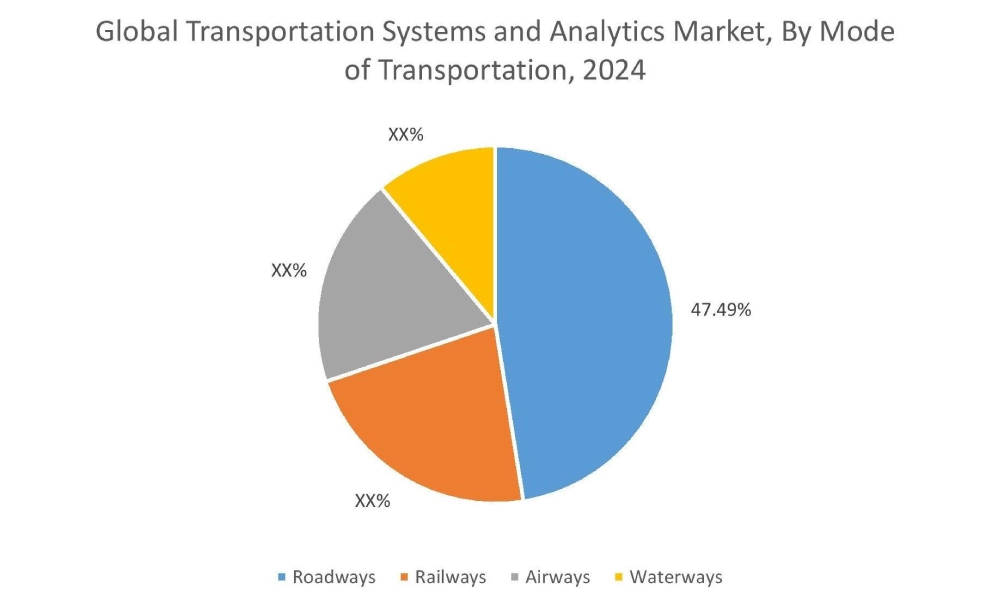
By Application:
Based on the application, the market is segmented into traffic management, fleet management, public transportation management, logistics and supply chain management, road safety management, passenger information management, remote sensing, and others.
Trends in the application:
- Increasing adoption of transportation systems and analytics solutions for logistics and supply chain management due to the need for route optimization in the last mile delivery.
- There is a rising trend towards the utilization of software management and analytics solutions for traffic management by governments.
Logistics and supply chain management accounted for the largest revenue share in the year 2024.
- The dominance of logistics and supply chain management solutions is attributed to the growing needs for businesses to efficiently plan routes during different stages of the supply chain.
- Businesses have witnessed an increasing need to deploy analytics solutions for real time monitoring of trucks and other vehicles used for goods transportation to ensure efficiency and customer satisfaction.
- Moreover, many companies today offer automated assignment and dispatching of goods eliminating delays in delivery.
- For instance,Onfleet offers the option of automated assigning, dynamic dispatching, and driver tracking to ensure the goods are delivered without any delays.
- Thus, the growing need to ensure timely delivery of goods in logistics and supply chain management is driving the overall transportation systems and analytics market trend, as per the analysis.
Fleet management anticipated to register significant CAGR during the forecast period.
- Many companies today offer traffic management solutions to monitor vehicle diagnostics and fleet efficiency.
- The integration of telematics to track the distance travelled and optimizing fuel performance has also driven the market.
- For instance,Samsara offers solutions that use both telematics and software to help businesses manage their fleet’s electrification journey. The company offers many features including the ability to monitor and compare the mileage of legacy vehicles with electric vehicles to better understand fuel and maintenance costs.
- Thus, the increasing use of telematics and software for effective management in fleet management is driving the transportation systems and analytics industry as per the analysis.
Regional Analysis:
The regions covered are North America, Europe, Asia Pacific, the Middle East and Africa, and Latin America.
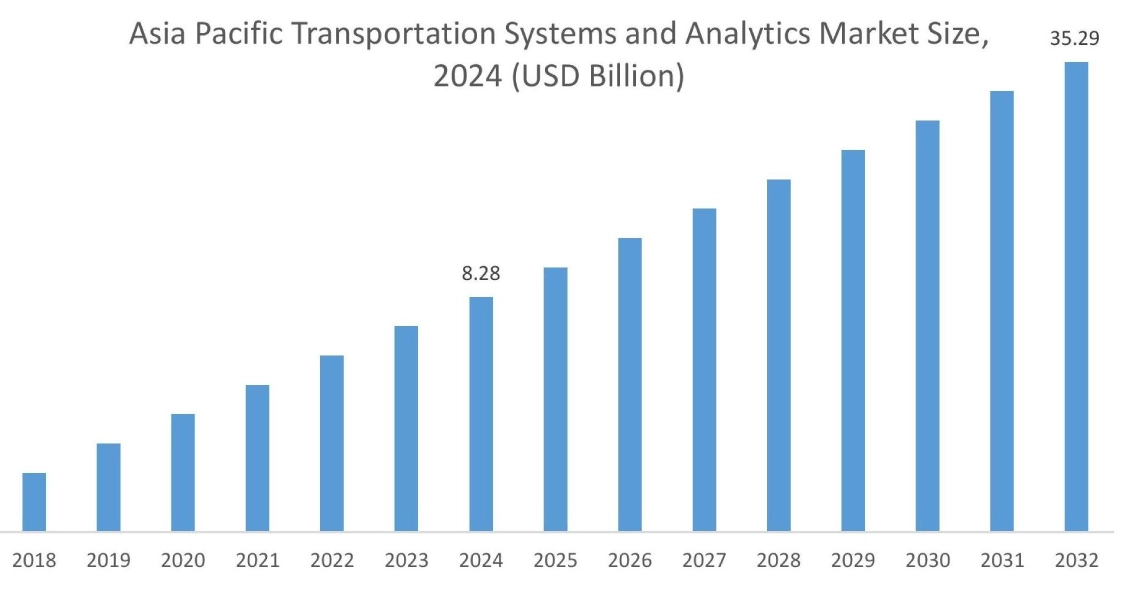
Asia Pacific region was valued at USD 8.28 Billion in 2024. Moreover, it is projected to grow by USD 9.77 Billion in 2025 and reach over USD 35.29 Billion by 2032. Out of this, China accounted for the maximum revenue of 35.45%. As per the transportation systems and analytics market analysis, the adoption of analytics and system management in transportation is primarily driven by the growing investments in analytics for logistics and supply chain management and growing need to effectively handle traffic using traffic management solutions, among others.
- For instance, according to Tomtom, Kolkata, Bengaluru, Pune, Kyoto are some of the most congested cities in the world.
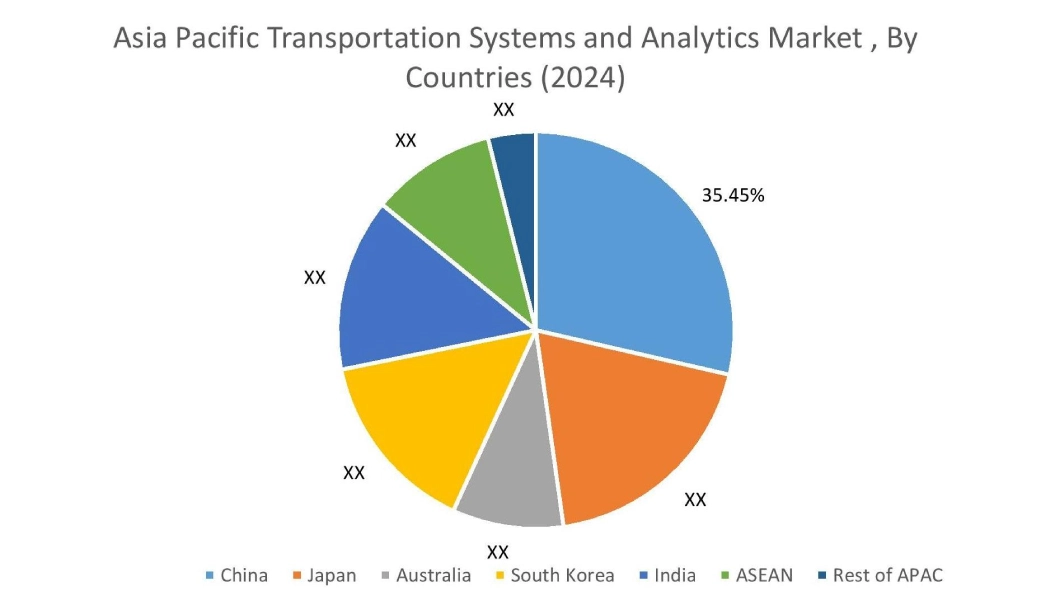
North America is estimated to reach over USD 38.09 Billion by 2032 from a value of USD 9.15 Billion in 2024 and is projected to grow by USD 10.78 Billion in 2025. In North America, the development of the market is driven by the growing investments in road safety management, logistics, and supply chain management. Moreover, the presence of a large number of companies offering analytics and software for fleet management is driving the regional development.
- For instance, Trimble offers accurate GPS routing for Light, Medium, and Heavy Duty Vehicle fleets in its fleet management software. The company also offers routes that are optimized for fuel consumption, resulting in lower fuel costs for taxi fleet owners.
Additionally, the regional study depicts that the growing use of ship management software and aircraft analytics software by businesses is driving the market demand in Europe. Furthermore, as per the market analysis, the market in Latin America is expected to grow at a considerable rate due to the rising adoption of transportation systems software for use in public transportation. The Middle East and African region is expected to grow at a considerable rate due to factors such as the growing need to handle public transportation management through software, the increase in adoption of analytics tools for supply chain management, and the growing demand for passenger information management tools, among others.
Top Key Players & Market Share Insights:
The global transportation systems and analytics market report suggest the market is highly competitive with major players providing solutions to the national and international markets. Key players are adopting several strategies in research and development (R&D), product innovation, and end-user launches to hold a strong position in market. Key players in the transportation systems and analytics industry include-
Recent Industry Developments :
Product Launch:
- In February 2024, Geotab unveiled Geotab Ace, an AI co-pilot designed specifically for fleets. Geotab Ace enhances user experience by offering custom and tailored insights through intuitive dialogue. It accesses a vast array of data that includes predictive safety analytics, trip data, predictive maintenance data, and GPS tracking, among others.
- In October 2024, Seyond announced the launch of the Seyond Intersection Management Platform (SIMPL). The solution uses LiDAR technology with Artificial Intelligence to analyze and optimize traffic signal controls based on real-time traffic data.
Transportation Systems and Analytics Market Report Insights :
| Report Attributes | Report Details |
| Study Timeline | 2019-2032 |
| Market Size in 2032 | USD 122.48 Billion |
| CAGR (2025-2032) | 21.9% |
| By Solution |
|
| By Deployment |
|
| By Mode of Transportation |
|
| By Application |
|
| By Region |
|
| Key Players |
|
| North America | U.S. Canada Mexico |
| Europe | U.K. Germany France Spain Italy Russia Benelux Rest of Europe |
| APAC | China South Korea Japan India Australia ASEAN Rest of Asia-Pacific |
| Middle East and Africa | GCC Turkey South Africa Rest of MEA |
| LATAM | Brazil Argentina Chile Rest of LATAM |
| Report Coverage |
|
Key Questions Answered in the Report
How big is the transportation systems and analytics market? +
The transportation systems and analytics market is estimated to reach over USD 122.48 Billion by 2032 from a value of USD 29.50 Billion in 2024 and is projected to grow by USD 34.73 Billion in 2025, growing at a CAGR of 21.9% from 2025 to 2032.
Which is the fastest-growing region in the transportation systems and analytics market? +
Asia-Pacific region is experiencing the most rapid growth in the transportation systems and analytics market.
What specific segmentation details are covered in the transportation systems and analytics market report? +
The transportation systems and analytics market report include specific segmentation details for solution, deployment, mode of transportation, and application.
Who are the major players in the transportation systems and analytics market? +
The key participants in transportation systems and analytics market are Oracle (U.S.), SAP SE (Germnay), PCS software (U.S.), Cargoson (Estonia), Trimble Inc. (U.S.), Kaleris (U.S.), Inrix (U.S.), StarTree Inc. (U.S.), Intangles (India), Manhattan Associates (U.S.), and Others.
